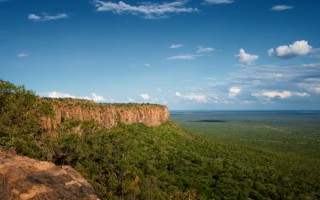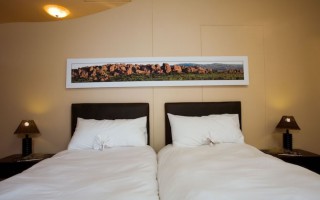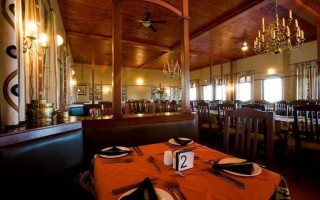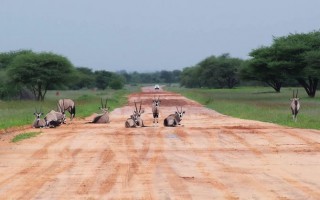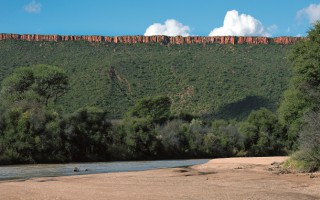The Establishment
Waterberg Plateau Park
Waterberg0:30 from Otjiwarongo
Waterberg Camp nestles along the base of the cliffs of the Waterberg Plateau, inside the National Park of the same name. It towers some 200m above the surrounding landscape, and the plateau with its sheer cliffs and fascinating rock formations, serve as a breeding area for endangered animal species.
Accommodation is in a combination of double rooms, premier (bush) and family chalets. Each room has an en-suite bathroom, with wrought iron vanity units and ceramic basins, (complementary toiletries and soft towels), a ceiling fan, twin bed with comfortable bedding, bedside lamps, a wardrobe, a dressing table with mirror, a couple of lounge chairs, a tea/coffee station and a mini- fridge. A big sliding door leads into a private porch area, complete with table and chairs. Some of the rooms have barbeque facilities.
The restaurant and bar are still located in the old, historic Rasthaus, which was built in 1908 and originally used as a police post.Breakfast is served between 06h30 and 08h30, and consists of a buffet offering cereals, fruit, yoghurt, breads, cheese, meats and eggs and bacon. Tea and coffee are available throughout the day. Dinner is served between 19h00 and 21h00, with a choice from the chef's à la carte menu. The food and service here are of a decent standard, it has always had the reputation as one of Namibia's best rest camps.
Our GPS co-ordinates are: 20°30'51.74"S and 17°14'45.34"E
Did You Know?
- Waterberg Plateau Park is a national park in central Namibia encompassing the Waterberg Plateau, 68 km east of the town of Otjiwarongo. The Waterberg Plateau is a particularly prominent feature, elevated high above the plains of the Kalahari of Eastern Namibia. The plateau and some 405 km² of surrounding land were declared a Nature Reserve in 1972. The plateau is largely inaccessible so in the early 1970s several of Namibia's endangered species were translocated there to protect them from predators and poaching to extinction. The programme was very successful and Waterberg now supplies other Namibian parks with rare species. In 1989, Black Rhino were reintroduced to the area from Damaraland, sparking a successful breeding programme of national and international significance for the species.
- The Waterberg Plateau Park is ecologically diverse and rich and has over 200 different species of bird and some rare species of small antelope on the lower hills of the mountain.
- Geologically, the oldest rock stratum is over 850 million years old and dinosaurs tracks were left there some 200 million years ago. The first human inhabitants were the San people, who left rock engravings believed to be several thousand years old. A small tribe of the San were still living their traditional lifestyle on the plateau until the late 1960s.
- The site is also home to one of the major turning points in Namibia's History. It was at Waterberg, in the foothills, that the Herero people lost their last and greatest battle against German colonial forces at the beginning of the 20th century. The Herero were forced to retreat from the Waterberg and headed eastward to British Bechuanaland (now Botswana). Thousands were killed by the pursuing Germans and many lost their lives in the Kalahari Desert due to lack of food and water. Estimates are that nearly two thirds of the Herero population lost their lives during this period. The graves of German soldiers who lost their lives at Waterberg can still be viewed near the waterberg rest camp at the base of the park.
What To Do?
- Guided morning and afternoon game drives
- Guided and self-guided trails on plateau
- Nature walks within the camp
